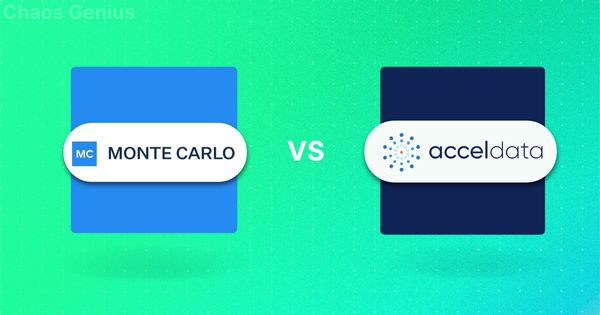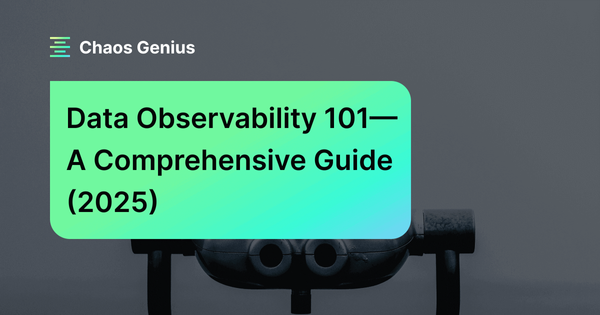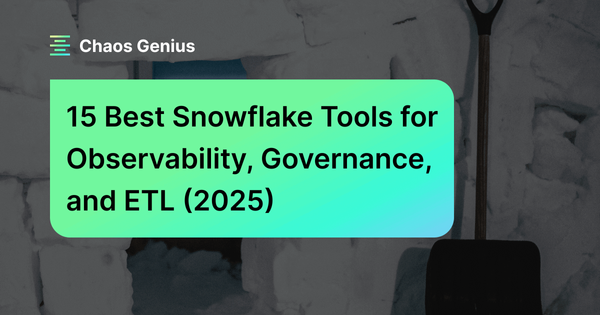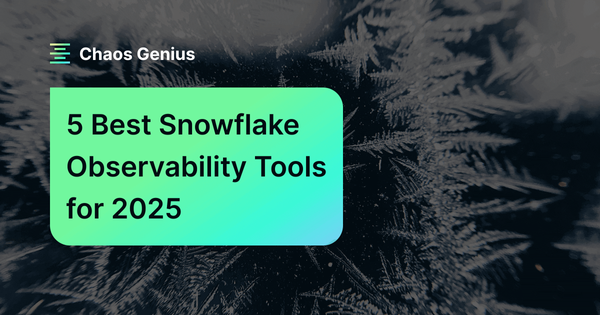Reliable, timely, and accurate data is the backbone of any successful business. But as data moves through complicated technology landscapes, risks arise that can slow down data pipelines and make operations extremely hard to run. So without proper Data Observability, businesses fly blind and can incur substantial costs from outages, bottlenecks, and poor data quality. New Data Observability tools and platforms are emerging that provide enhanced visibility so data teams can monitor data pipelines, quickly resolve issues, and ensure reliable delivery of trustworthy data.
In this article, we will compare two of the popular Data Observability platforms—Monte Carlo Data and Acceldata. We'll evaluate their key capabilities, how they compare in terms of core features, ecosystem support, pricing, and more to help you choose the right platform.
What is Data Observability?
Data Observability is an organization's ability to see, understand and improve the health, quality and performance of data across its entire lifecycle. This includes using automated monitoring, anomaly detection, root cause analysis, data lineage tracking and data quality metrics to actively identify, diagnose, resolve and prevent data issues.
Read more here if you want to get into the nitty gritty of what is Data Observability, Key components of Data Observability, what are the benefits of implementing Data Observability and why it matters.

Want to take Chaos Genius for a spin?
It takes less than 5 minutes.

What are Data Observability tools?
Now that we have a clear cut understanding of Data Observability, let's dive into the concept of Data Observability tools. These tools are designed to help users, businesses, or organizations monitor, understand, and improve the health and reliability of their own data.
Here are some key capabilities of these Data Observability tools as true Data Observability tools:
- Data Observability tools provide automated and continuous monitoring of data systems to detect issues and anomalies, including monitoring data in motion as it flows through pipelines as well as data at rest in databases/warehouses.
- Going beyond monitoring, Data Observability tools enable deeper understanding of data health through automated profiling, quality checks, and root cause analysis of problems.
- Data Observability tools maintain metadata like lineage, schema changes, and freshness to provide rich contextual insight into the data.
- Data Observability tools generate actionable and prioritized alerts when problems are uncovered to facilitate rapid response.
- Data Observability tools support collaboration by giving various stakeholders shared visibility into data problems and their downstream impact.
- Data Observability tools utilize advanced techniques like machine learning and statistical analysis to automatically learn normal data patterns and detect deviations.
- Data Observability tools provide intuitive visualizations and dashboards for easy access to data health metrics.
- Data Observability tools integrate with and ingest data from existing warehouses, pipelines, BI tools and other data infrastructure.
- Data Observability tools generate alerts and notifications when anomalies are detected. These alerts are actionable and help teams prioritize response.
Now that we have a clear understanding of Data Observability tools, let's delve into the core of this article, where we will compare two prominent Data Observability tools—Monte Carlo vs Acceldata.
What is Monte Carlo Data?
Founded in 2019, Monte Carlo is a leading Data Observability platform designed to automate the monitoring of data quality across an organization's entire data stack. It uses machine learning. It detects and alerts teams about data issues. These issues include freshness, distribution, volume, schema, and lineage. Monte Carlo gives full visibility into data pipelines. It does this through an easy, no-code setup. This setup lets data engineers and teams find and fix data problems efficiently. The platform supports observability for various different platforms, including Snowflake.

TL;DR: Monte Carlo is one of the best solutions designed specifically for achieving complete Data Observability. It gives data teams the missing visibility and control needed to keep complex data environments healthy and downtime-free.
Monte Carlo Data—Overview of Key Capabilities
Monte Carlo data platform delivers several key capabilities:
1) Comprehensive Observability
The platform connects to existing data infrastructure such as cloud warehouses (like Snowflake), data lakes, ETL tools, and BI tools to gain complete observability into the entire data stack.
2) Intelligent Monitoring via ML
Monte Carlo data leverages machine learning to establish baseline patterns in normal data environments. It then monitors for abnormalities and triggers alerts when potential problems arise, enabling data issue detection before any downtime occurs.
3) Automated Root Cause Analysis
But wait! When problems do occur, Monte Carlo performs automated root cause analysis to pinpoint the source of the incident quickly.
4) Data Lineage and Cataloging
Monte Carlo data provides data lineage tracing and cataloging to deliver insights into data location, ownership, health, and accessibility.
5) Secure Plus Scalable Architecture
With a security-first design, Monte Carlo scales to any data size without extracting or storing customer data. Only metadata is retained to enable monitoring and analytics.
6) No-Code/Low-code Onboarding
Monte Carlo data features no-code onboarding for rapid implementation across the data stack, which simplifies rollout and usage.
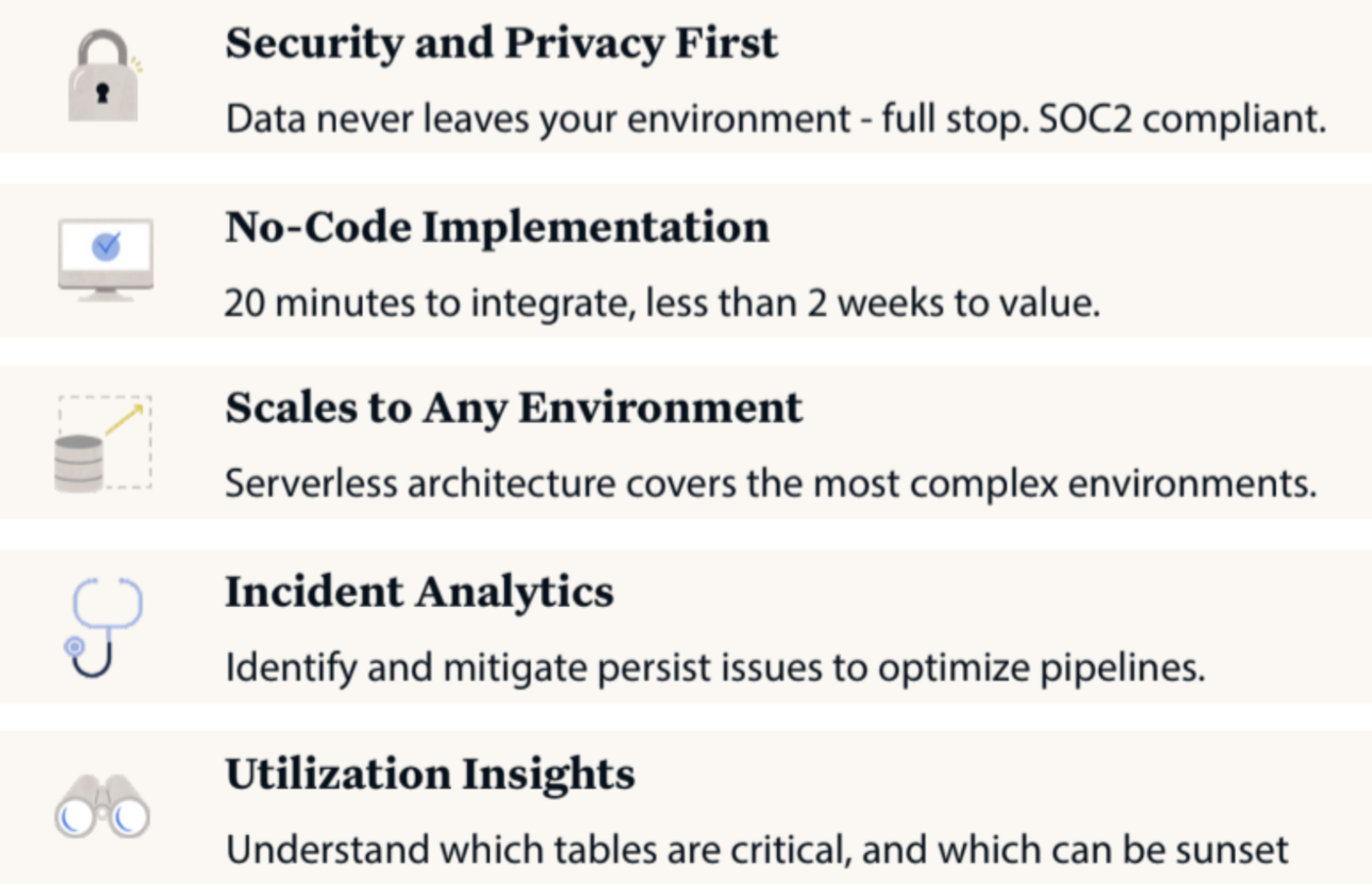
What is Acceldata?
Acceldata is a Data Observability platform designed to help data teams monitor, operate, and optimize modern data systems. It provides deep visibility into various aspects of data processing, pipeline performance, and data quality across diverse and complex data environments.

Acceldata platform delivers several key capabilities:
1) Automated Anomaly Detection
Acceldata uses AI to continuously monitor data pipelines and detect anomalies and alert you in real-time to act fast.
2) Root Cause Analysis
The platform shows you the root cause of the data issue so you can fix it fast and minimize downtime.
3) Predictive Analytics
Acceldata helps prevent disruptions. It also optimizes resource use. It does this by predicting data anomalies and performance bottlenecks.
4) Customizable Dashboards
Users can see all data pipelines on dashboards. The dashboards are intuitive and tailored to their business needs.
5) Shift Left Data Observability
Acceldata integrates observability from data landing zone to consumption. It cuts the cost of bad data by catching issues early in the data lifecycle.
6) Petabyte Scale Data Handling
The platform can process billions of rows of data. It does this with in-memory processing and horizontal scaling. So, its performance doesn’t get worse at scale.
7) Cloud and On-Premises Compatibility
Acceldata supports hybrid data environments. It has a single pane of glass for Data Observability. This works across both cloud and on-premises.
8) Enterprise-Class Security
Acceldata has SOC2 Type 2 certification. It uses IP-based access controls and multi-factor authentication. It also uses role-based access control (RBAC) and more to keep your data safe.
9) Intelligent Alerts and Recommendations
The platform provides ML-based recommendations for data reliability. It also gives intelligent alerts. They help you prioritize and fix data issues fast.
10) Self-Healing Capabilities
Acceldata has automated remediation features to reduce operational costs and burden on engineering teams.
11) No-Code and Low-Code Rule Authoring
Data teams can make data reliability rules with low-code visuals. Or, they can start with pre-built templates. These options support complex enterprise use cases.
Key Data Observability Features Compared—Monte Carlo Vs Acceldata
| Feature | Monte Carlo | Acceldata |
|---|---|---|
| Core Capabilities | ||
| End-to-end Visibility | ✅ Yes, lineage from source to destination, focus on data assets | ✅ Yes, full lineage, including landing zones, transformations, and infrastructure |
| Data Quality Monitoring | ✅ Yes, anomaly detection, freshness checks, volume checks, schema change detection | ✅ Yes, anomaly detection, data drift detection, rule-based validation, custom SQL/Python checks, ML-based anomaly detection |
| Root Cause Analysis | ✅ Yes, ML-powered root cause analysis, auto-triage of incidents | ✅ Yes, ML-powered root cause analysis, correlated alerts, dependency mapping |
| Observability | ✅ Yes, data profiles, field-level lineage, query monitoring | ✅ Yes, data profiles, field-level lineage, query monitoring, infrastructure monitoring, pipeline health monitoring |
| Incident Management | ||
| Alerting & Notifications | ✅ Yes, real-time alerts, customizable thresholds, various notification channels | ✅ Yes, real-time alerts, customizable thresholds, quarantine policy, circuit breaker for data isolation, automated incident creation, various notification channels |
| Remediation | ✅ Yes, automated lineage-driven root cause analysis, suggested fixes, collaboration tools | ✅ Yes, automated lineage-driven root cause analysis, auto-generated remediation workflows, integration with incident management tools |
| Advanced Features | ||
| Data Catalog | ❌ Not directly built-in, integrations with third-party catalogs | ✅ Yes, integrated data catalog with data discovery, tagging, and search capabilities |
| Cost Optimization | ✅ Yes, monitors query runtime and data usage, identifies cost optimization opportunities | ✅ Yes, deep cost visibility, query optimization, infrastructure right-sizing recommendations, proactive cost anomaly detection |
| Data Governance | ✅ Yes, data lineage for governance insights, policy management through integrations | ✅ Yes, comprehensive data governance, lineage-driven policy creation and enforcement, role-based access control |
| ML Observability | ✅ Yes, tracks ML model performance metrics | ❌ Not explicitly mentioned |
| Integrations | ✅ 50+ connectors to popular data warehouses, lakes, BI tools, and collaboration platforms | ✅ 38+ connectors to popular data warehouses, lakes, lakehouses, BI tools, and collaboration platforms, including deep integrations with Databricks and Snowflake |
| AI/ML Integration | ✅ Yes, ML-powered anomaly detection, root cause analysis, incident triage | ✅ Yes, ML-powered anomaly detection, root cause analysis, incident triage, data policy recommendations, query optimization |
| Pricing | ||
| Pricing | Custom Quote | Not specified ❌ | Custom Quote | 30-day free trial |
Monte Carlo—Overall Breakdown
Key Features of Monte Carlo:
- Real-time alerts for immediate issue detection.
- Automated data catalog and metadata management for seamless organization.
- ML-powered incident monitoring and resolution for efficient problem-solving.
- Data validation to ensure data accuracy and reliability.
- No-code onboarding for easy implementation and usage.
- Data visualization for intuitive data insights.
- End-to-end visibility into data systems for comprehensive observability.
- Anomaly identification using machine learning algorithms.
- Data lineage tracking to trace errors and assess downstream impact.
- Supports 50+ pre-built connectors for seamless integration.
Ratings:
| 4.7 out of 5 stars on G2 |
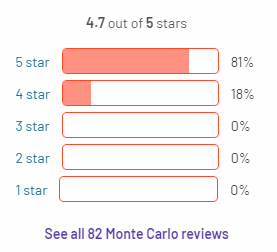
|
| MonteCarlo data G2 ratings (Source: Monte Carlo review) |
| 5.0 out of 5 stars on Gartner |
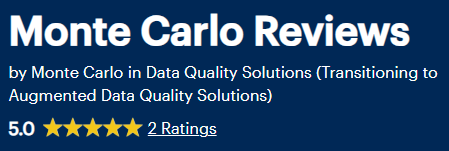
|
| MonteCarlo data Gartner ratings (Source: Monte Carlo review) |
Pros of Monte Carlo:
- Extremely valuable for improving data quality. Monte Carlo provides robust observability for multitude of platforms.
- Monte Carlo team offers exceptional customer support, enabling users to receive prompt assistance with any issues.
- User-friendly and intuitive UI design makes the platform easy to use even for non-technical users. Minimal training is needed.
- Built-in anomaly detection, leveraging machine learning algorithms, Monte Carlo monitors data and alerts on abnormalities.
- Monte Carlo provides data lineage and impact radius analysis, allowing tracing errors back to root cause and assessing downstream impact.
- Monte Carlo’s AI and machine learning capabilities automate identification of data quality issues, reducing manual effort.
- The platform provides Seamless integration with popular data tools and multitude of platforms and integrations.
Cons of Monte Carlo:
- Limited native integration support for some niche data monitoring tools.
- Can be too complex for users with very basic technical skill sets. Advanced troubleshooting requires training.
- Fully customizing anomaly detection and data quality rules requires technical expertise. Out-of-box offerings are more limited.
- Lack of Jira integration support.
- The insights offered in the business intelligence layer are high-level. Users may want more detailed analytics.
Pricing:
Monte Carlo Data hasn't publicly disclosed pricing information. Interested users have to get in touch with sales representatives to get a quote based on their specific requirements.
Acceldata—Overall Features Breakdown
Key features of Acceldata:
- Real-time alerts and monitoring for proactive issue management.
- Data governance for comprehensive data management.
- Data validation to ensure data accuracy and consistency.
- Cost optimization for efficient resource utilization.
- Anomaly detection for active issue detection.
- Automated AI/ML-powered issue detection for efficient problem-solving.
- SDK for data pipeline monitoring for customization and control.
- Comprehensive infrastructure and compute monitoring for comprehensive observability.
- Data asset discovery and annotation for enhanced data insights.
- Supports well over 38+ pre-built connectors for seamless integration.
Ratings:
| 4.3 out of 5 stars on G2 |
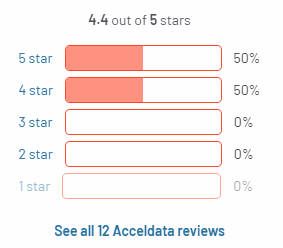
|
| Acceldata G2 ratings (Source: Acceldata Review) |
| 4.8 out of 5 stars on Featured Customers |
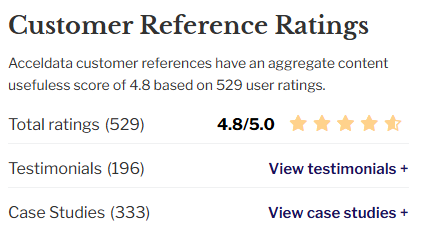
|
| Acceldata Featured Customers ratings (Source: Acceldata Review) |
Pros of Acceldata:
- Provides automatic monitoring and management of big data pipelines through an intuitive UI
- Enables real-time Data Observability on a variety of platforms (Like Snowflake, dbt, AWS, Spark, Hive, Hadoop—and much more)
- Advanced anomaly detection and alerting capabilities to detect issues actively
- Powerful data lineage and impact analysis to accelerate root cause investigation
- Provides robust security with granular access controls, encryption, data masking , data governance—and more!!
- Highly flexible and scalable architecture built for enterprise environments
- Seamless integration with existing data infrastructure and BI tools
- Significantly reduces debugging time with visual insights and optimizations
Cons of Acceldata:
- Steep learning curve to master some advanced customizations
- Adding/removing nodes requires manual configuration and tuning
- Out-of-the-box dashboards can seem overwhelming
- Limited native support for ingesting non-Hadoop metrics
- Occasional stability issues and bugs from rapid feature development
- Pricing is higher compared to other tools
- Smaller market presence than leading observability platforms
- Smaller community and limited support ecosystem
Pricing:
Acceldata utilizes a customized, quotation-based pricing model rather than a fixed tiered pricing structure. Pricing is tailored to each customer's specific use case and deployment size. While exact pricing is not disclosed publicly, Acceldata does provide a 30-day free trial to evaluate the platform.
Conclusion
That's it! Now you can make your own decision on which Data Observability platform is right for you. Both provide Data Observability but now you can choose which one fits your needs and which one is better for you. In this post we compared two of the top Data Observability platforms—Monte Carlo Data and Acceldata—and broke down their key features, ecosystem support, pricing and more to help you decide the best fit.
FAQs
How does observability differ from monitoring?
Observability is proactive, while monitoring is reactive. Observability aims to gain deep insights into system behavior.
Why is observability important overall?
It allows quicker identification and resolution of operational issues before they impact customers.
How does Monte Carlo's Data Observability platform automate data quality monitoring?
Monte Carlo's platform utilizes machine learning to automate data quality monitoring. It continuously tracks data freshness, distribution, volume, schema changes, and lineage to detect and alert teams about data issues.
What are the key strengths of Monte Carlo and Acceldata for Data Observability?
Monte Carlo delivers real-time monitoring, automated alerts, and ML-powered data validation with 35+ pre-built connectors for fast setup. Acceldata has broad connectivity with more pre-built connectors and adds robust data governance and lineage capabilities, but lacks real-time alerting. Monte Carlo excels at AI-driven observability, while Acceldata focuses on full observability with robust data governance.
Does Acceldata support data governance and cost optimization features?
Yes, Acceldata provides data governance and cost optimization capabilities. It offers granular access controls, encryption, and data masking, enabling users to optimize infrastructure and reduce costs.
What are the pricing models for both Monte Carlo and Acceldata's Data Observability tools?
Monte Carlo's pricing is not publicly disclosed, and users need to contact sales representatives for a custom quote. Acceldata utilizes a customized, quotation-based pricing model with a 30-day free trial available.
How can data teams leverage AI and ML capabilities for incident monitoring and resolution with Monte Carlo?
Monte Carlo's AI and ML capabilities automate the identification of data quality issues, reducing manual effort for data teams. It actively monitors data and alerts on abnormalities, enabling quick incident resolution.
Does Monte Carlo provide no-code onboarding for easy implementation across data stacks?
Yes, Monte Carlo offers no-code onboarding, making it easy for data teams to implement the platform across their data stacks without extensive technical expertise.
How does Acceldata streamline issue detection and reduce debugging time for big data pipelines?
Acceldata provides real-time alerts and automated AI/ML-powered issue detection. Its visual insights and optimizations significantly reduce debugging time for big data pipelines.
What integration options are available for both tools with existing data infrastructure and BI tools?
Both Monte Carlo and Acceldata offer seamless integration with existing data infrastructure and BI tools, ensuring smooth compatibility and easy adoption.
Can I try Acceldata for free before committing to a subscription?
Yes, Acceldata provides a 30-day free trial, allowing users to evaluate the platform before making a subscription decision.



































